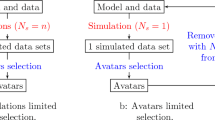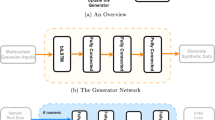Abstract
Dosing requires consideration of diverse patient-specific factors affecting drug pharmacokinetics and pharmacodynamics. The available pharmacometric methods have limited capacity for modeling the inter-relationships and patterns of variability among physiological determinants of drug dosing (PDODD). To investigate whether generative adversarial networks (GANs) can learn a generative model from real-world data that recapitulates PDODD distributions. A GAN architecture was developed for modeling a PDODD panel comprised of: age, sex, race/ethnicity, body weight, body surface area, total body fat, lean body weight, albumin concentration, glomerular filtration rate (EGFR), urine flow rate, urinary albumin-to-creatinine ratio, alanine aminotransferase to alkaline phosphatase R-value, total bilirubin, active hepatitis B infection status, active hepatitis C infection status, red blood cell, white blood cell, and platelet counts. The panel variables were derived from National Health and Nutrition Examination Survey (NHANES) data sets. The dependence of GAN-generated PDODD on age, race, and active hepatitis infections was assessed. The continuous PDODD biomarkers had diverse non-normal univariate distributions and bivariate trend patterns. The univariate distributions of PDODD biomarkers from GAN simulations satisfactorily approximated those in test data. The joint distribution of the continuous variables was visualized using three 2-dimensional projection methods; for all three methods, the points from the GAN simulation random variate vectors were well dispersed amongst the test data. The age dependence trend patterns in GAN data were similar to those in test data. The histograms for R-values and EGFR from GAN simulations overlapped extensively with test data histograms for the Hispanic, White, African American, and Other race/ethnicity groups. The GAN-simulated data also mirrored the R-values and EGFR changes in active hepatitis C and hepatitis B infection. GANs are a promising approach for simulating the age, race/ethnicity and disease state dependencies of PDODD.






Similar content being viewed by others
References
McComb M, Bies R, Ramanathan M (2022) Machine learning in pharmacometrics: opportunities and challenges. Br J Clin Pharmacol 88:1482–1499
McComb M, Ramanathan M (2020) Generalized pharmacometric modeling, a Novel paradigm for integrating machine learning algorithms: a case study of metabolomic biomarkers. Clin Pharmacol Ther 107:1343–1351
Knights J, Heidary Z, Peters-Strickland T, Ramanathan M (2019) Evaluating digital medicine ingestion data from seriously mentally ill patients with a bayesian hybrid model. NPJ Digit Med 2:20
Knights J, Sato Y, Kaniwa N, Saito Y, Ueno H, Ramanathan M (2014) Genetic factors associated with gemcitabine pharmacokinetics, disposition, and toxicity. Pharmacogenet Genomics 24:15–25
McComb M, Blair RH, Lysy M, Ramanathan M (2022) Machine learning-guided, big data-enabled, biomarker-based systems pharmacology: modeling the stochasticity of natural history and disease progression. J Pharmacokinet Pharmacodyn 49:65–79
Goodfellow IJ et al (2014) Generative Adversarial Networks. arXiv, arXiv:1406.2661 [stat.ML]
National Health and Nutrition Examination Survey (2017) About the National Health and Nutrition Examination Survey. National Center for Health Statistics, Hyattsville, MD
Dubois D, Dubois EF (1916) A formula to estimate the approximate surface area if height and weight be known. Arch Intern Med 17:863–871
Inker LA et al (2021) New creatinine- and cystatin C-based equations to estimate GFR without race. N Engl J Med 385:1737–1749
Chalasani NP et al (2014) ACG clinical guideline: the diagnosis and management of idiosyncratic drug-induced liver injury. Am J Gastroenterol 109, 950–966; quiz 67
Ruhl CE, Everhart JE (2012) Upper limits of normal for alanine aminotransferase activity in the United States population. Hepatology 55, 447–454
Gonzalez H et al (2020) Normal alkaline phosphatase levels are dependent on race/ethnicity: NationalGEP Health and Nutrition Examination Survey data.BMJ Open Gastroenterol7, 1
National Health and Nutrition Examination Survey (2015) National Health and Nutrition Examination Survey: NHANES 2015–2016 overview. (ed. National Center for Health Statistics) (Centers for Disease Control)
R Core Team. R: a language and environment for statistical computing (2022)
Lin Z, Khetan A, Fanti G, Oh S(2017) PacGAN: the power of two samples in generative adversarial networks. arXiv, arXiv:1712.04086
Xu L, Skoularidou M, Cuesta-Infante A, Veeramachaneni K Modeling tabular data using conditional GAN In 33rd Conference on Neural Information Processing Systems (NeurIPS 2019) eds. Wallach, H., Larochelle, H., Beygelzimer, A., d’Alché-Buc, F., Fox, E. and Garnett, R.)
Paszke A et al (2019) PyTorch: An Imperative Style, High-Performance Deep Learning Library. Advances in Neural Information Processing Systems 32 (NIPS, 32, (2019)
Krijthe JH, Rtsne (2015) T-distributed stochastic neighbor embedding using Barnes-Hut implementation
van der Maaten LJP, Hinton GE (2008) Visualizing high-dimensional data using t-SNE. J Mach Learn Res 9:2579–2605
McInnes L, Healy J, Melville JUMAP (2018) Uniform manifold approximation and projection for dimension reduction. arXiv:180203426 [statML]
Barras M, Legg A (2017) Drug dosing in obese adults. Aust Prescr 40:189–193
Bteich M (2019) An overview of albumin and alpha-1-acid glycoprotein main characteristics: highlighting the roles of amino acids in binding kinetics and molecular interactions. Heliyon 5:e02879
Parikh HH et al (2000) A rapid spectrofluorimetric technique for determining drug-serum protein binding suitable for high-throughput screening. Pharm Res 17:632–637
Hinderling PH (1997) Red blood cells: a neglected compartment in pharmacokinetics and pharmacodynamics. Pharmacol Rev 49, 279–295
Center for Biologics Evaluation and Research & Center for Drug Evaluation and Research. Guidance for Industry: Drug-Induced Liver Injury: Premarketing Clinical Evaluation (2009)
Zimmerman HJ (1978) Drug-induced liver disease. Drugs 16:25–45
Author information
Authors and Affiliations
Contributions
RN–Conducted experiments, data analysis, manuscript preparation. DDM–Assisted with experiments, data analysis, manuscript preparation. SS–Study concept and design, data analysis, manuscript preparation. VG–Study oversight, manuscript review. MR–Study concept and design, data analysis, manuscript preparation.
Corresponding author
Ethics declarations
Conflict of interest
Rahul Nair and Deen Dayal Mohan have no conflicts. Srirangaraj Setlur and Dr. Venu Govindaraju received unrelated research funding from the National Science Foundation, United States Postal Service, and the Intelligence Advanced Research Projects Activity agencies. Dr. Murali Ramanathan received research funding from the National Science Foundation, Department of Defense, and the National Institutes of Health.
Additional information
Publisher’s Note
Springer Nature remains neutral with regard to jurisdictional claims in published maps and institutional affiliations.
Supplementary information
Below is the link to the electronic supplementary material.
Rights and permissions
Springer Nature or its licensor (e.g. a society or other partner) holds exclusive rights to this article under a publishing agreement with the author(s) or other rightsholder(s); author self-archiving of the accepted manuscript version of this article is solely governed by the terms of such publishing agreement and applicable law.
About this article
Cite this article
Nair, R., Mohan, D.D., Setlur, S. et al. Generative models for age, race/ethnicity, and disease state dependence of physiological determinants of drug dosing. J Pharmacokinet Pharmacodyn 50, 111–122 (2023). https://doi.org/10.1007/s10928-022-09838-4
Received:
Accepted:
Published:
Issue Date:
DOI: https://doi.org/10.1007/s10928-022-09838-4




